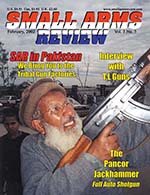SITREP: February 2002
By Dan Shea
Preparedness is more than just putting water into jugs, buying MREs and taking the Boy Scout Oath. Lately, “Preparedness” has been somewhat co-opted by what is referred to as the “Survivalist” school, and that is an unfortunate development- and not because a survivalist attitude is a bad thing. Being prepared is important and shouldn’t be relegated to one group of people and ignored by the rest. All of us need to be prepared for emergencies, and for many of us, just to do our jobs.
Specifically, “Preparedness” for law enforcement and military personnel means that you have the training time put in, and the inventory of needed items stocked up and maintained. In SAR we tend to emphasize training, whether it be martial discipline, rounds put downrange, or time on the workbench. We also spend a lot of time bringing sources of supply to our readers, so we cover the bases pretty well.
There is a third leg to that “Preparedness” stool- it is the Research & Development (R&D) performed within our industrial base as a country. It is necessary for R&D to be going on, for the industry to grow and keep our military strength in a state of the art condition. Many times we at SAR bring innovative and interesting people to the fore, in interviews and product reviews, sometimes by following the development of an historical weapon system.
I wanted to weigh in on something to do with R&D, and that is the fact that in the United States, it is increasingly difficult to accomplish anything in small arms design. We are not alone, many other countries have similar problems, or worse. To those who are trying to stop the supply of small arms to criminal regimes or terrorist groups, many times stopping all small arms production is seen as the solution.
If you consider that we could exist in a Utopian place, with no enemies, no “bad guys”, no threats to our homes, our families, our countries, then perhaps stopping “The proliferation of small arms” is a good idea. Since that is not only unrealistic, it is totally impossible, we are left with the need for defensive and offensive arms. Restrictions are not at discussion here- the fact that we need modern weapons is.
We cannot compete in a world where we are left with old technology, and our potential enemies are free to grow and experiment, free to obtain weapons for study, free to do R&D.
In the current situation in the United States, it is virtually impossible for an inventor or scientist to obtain firearms to do his research. There are few places in the world that will let the student of small arms in to view their collections, and fewer still that will allow hands on disassembly or firing of these items. Inventors may obtain a Class 3 Manufacturer’s FFL and SOT, but purchasing transferable firearms with their artificially inflated values, albeit market driven, is out of the loop for most inventors and the potential dissection or destructive testing they need to do.
I am not sure of the solution to this- I do know that almost every great leap forward in small arms has come from the private workshops- from the innovations of our first muskets to John Browning, to Stoner’s genesis of the M16 series. The list of our small arms that came from an inventor’s workshop and then went into the larger production facilities would be a fairly complete listing of the US Military’s TO&E.
How much are we missing out on? How many frustrated inventors have pointed their creative energies towards working on new carburetors, new vegematics, or better mousetraps, after facing the situation in the United States and how difficult it is to work on small arms? Have we missed the next step? Is it possible that the newest innovations will only come out of the big government contracted shops? Or have we lost many opportunities due to our over regulation of Title II firearms?
These are questions that we should be considering when we watch the innovations of other countries, questions we should be asking when we listen to people demanding more regulation. While we generally concentrate on views of our Right to Keep and Bear Arms in the United States, perhaps it is worth considering how we may be weakening our country in the long term, by regulating new innovations out of existence.
- Dan
This article first appeared in Small Arms Review V5N5 (February 2002) |
| SUBSCRIBER COMMENT AREA |
Comments have not been generated for this article.



